Weeds ID Map Weed Watchers
NATIVE PLANTS
Of the following Jenness Pond weeds many are grasses, rushes, or sedges. The easiest way to tell the difference between these plant families is to examine their stems:
grasses have round hollow stems
rushes have round solid stems
sedges have edges to their solid stems.
Bladderwort Utricularia
Description: The genus Utricularia has over 200 species. They are carnivorous - their bladders are literally hair-triggered and can trap small organisms! Some species live in the water others and on land, albeit the land must be wet. Aquatic species are submerged plants, except for the flower which is raised above the water surface by its stem.
There are about 10 species aquatic of bladderwort in New Hampshire. They have a long slender stem wth leaves attached in an alternating manner (not opposite each other). The plants are initially loosely attached to the bottom, but often become detached and float to the surface where thay may bunch together. The small flowers vary from yellow to pink.
One of the species found in Jenness Pond is common bladderwort - Utricularia vulgaris which has yellow flowers. Another is eastern purple bladderwort - Utricularia purpurea which has purple flowers. The leaves of this bladderwort are whorled with 3 or more leaves per node along the stem.
Similar to: Milfoil which does not have bladders. If you find small sacs on the plant that are easy to squeeze and even pop then the plant is a bladderwort, not mifoil.
Pond zone: Submergent.
Range: Much of the world including every US state.
Jenness Pond Status: Scattered, but common in some areas.
Image by: 1) Len Worthington 2) Common Bladderwort - Micheal_Curz 3) Common Bladderwort - Dick Daniels There are about 10 species aquatic of bladderwort in New Hampshire. They have a long slender stem wth leaves attached in an alternating manner (not opposite each other). The plants are initially loosely attached to the bottom, but often become detached and float to the surface where thay may bunch together. The small flowers vary from yellow to pink.
One of the species found in Jenness Pond is common bladderwort - Utricularia vulgaris which has yellow flowers. Another is eastern purple bladderwort - Utricularia purpurea which has purple flowers. The leaves of this bladderwort are whorled with 3 or more leaves per node along the stem.
Similar to: Milfoil which does not have bladders. If you find small sacs on the plant that are easy to squeeze and even pop then the plant is a bladderwort, not mifoil.
Pond zone: Submergent.
Range: Much of the world including every US state.
Jenness Pond Status: Scattered, but common in some areas.
4) Purple Bladderwort - Lauren 5) Purple Bladderwort - Jan Bushold
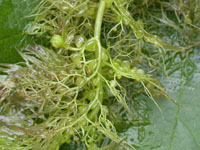
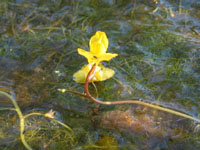
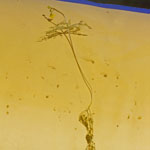
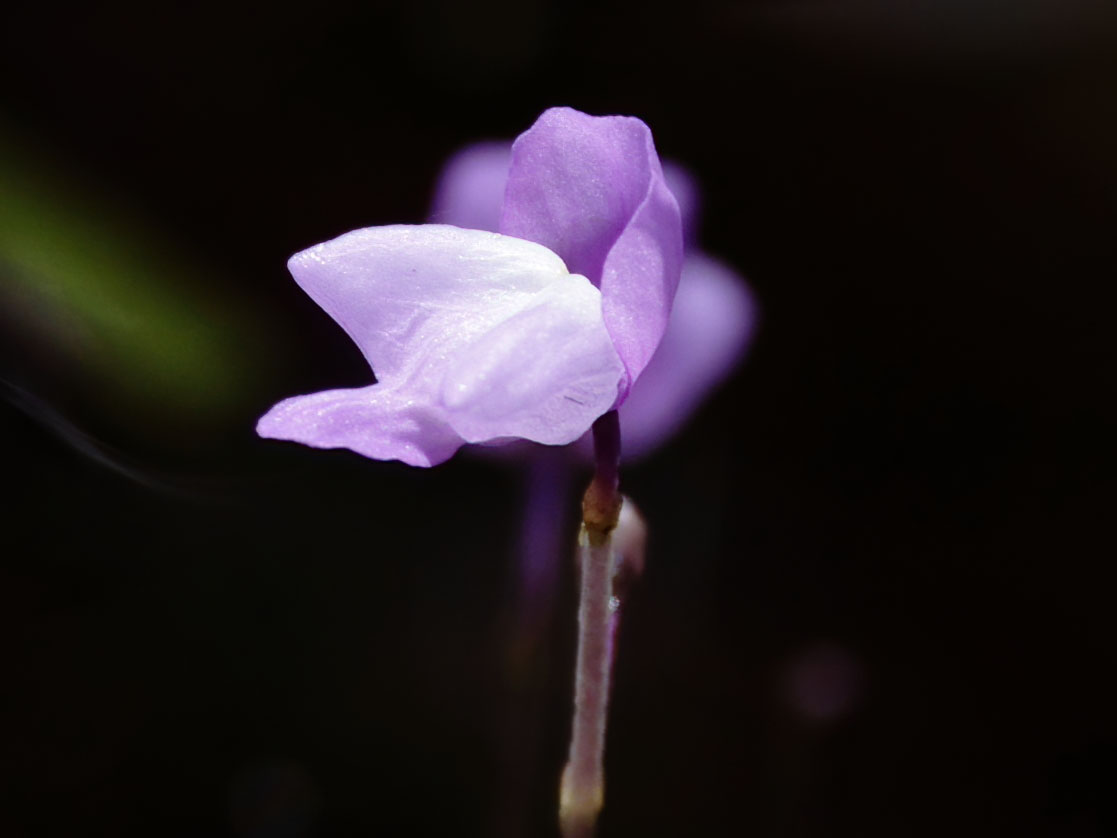
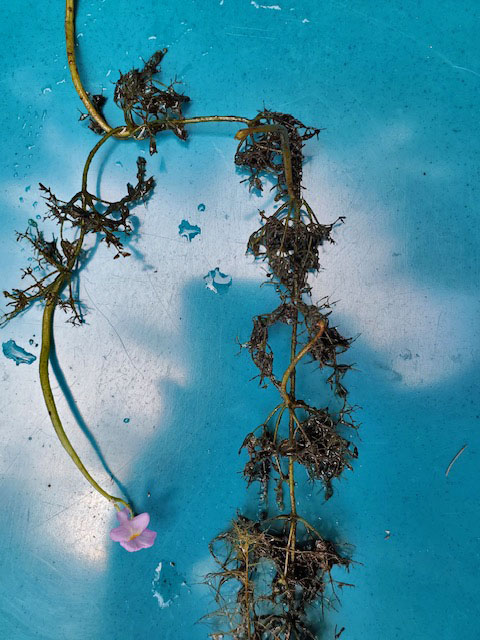
Bulrush, softstem Scirpus validus aka Schoenoplectus tabernaemontani
Description: Softstem bulrush grow 3 to 6 feet tall in shallow water and occurs in dense stands. There are brown flowers in late summer to early fall. It belongs to the sedge family Cyperaceae.
Similar to: From a distance softstem bulrush is similar to rush, but softstem bulrush is a sedge while rush has round stems.
Pond zone: Emergent.
Range: Much of the world including every US state.
Jenness Pond Status: Sparse
Image by: 1) Gertjan van Noord 2) Christian Fischer 3) Kevin ThieleSimilar to: From a distance softstem bulrush is similar to rush, but softstem bulrush is a sedge while rush has round stems.
Pond zone: Emergent.
Range: Much of the world including every US state.
Jenness Pond Status: Sparse
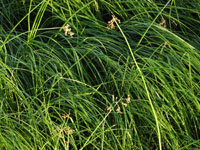

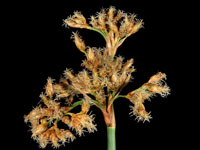
Bur-reed Sparganium
Description: There are many species of bur-reed in North America. The flowers are in spherical burr-like heads and the leaves are flat. The ones in Jenness Pond are found in shallow water, up to a foot deep. They belong to
the cattail family Typhaceae.
Some genera found in New Hampshire: Sparganium americanum, Sparganium androcladum, Sparganium angustifolium, Sparganium emersum, Sparganium eurycarpum, Sparganium fluctuans, Sparganium natans
Pond zone: Emergent.
Range: North America, Europe, Asia.
Jenness Pond Status: Common
Image by: 1, 2) Dick Daniels 3) Pat DowstSome genera found in New Hampshire: Sparganium americanum, Sparganium androcladum, Sparganium angustifolium, Sparganium emersum, Sparganium eurycarpum, Sparganium fluctuans, Sparganium natans
Pond zone: Emergent.
Range: North America, Europe, Asia.
Jenness Pond Status: Common

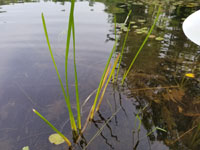
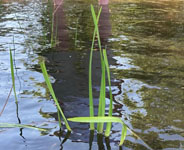
Floating Heart Nymphoides cordata
Description: The (little) floating heart has a heart shaped leaf that floats on the surface of the water. As shown below, it is much smaller than the leaf of a yellow waterlily. The little floating heart has a white 5-petalled flower.
Pond zone: Floating leaved.
Range: Eastern North America
Jenness Pond Status: Common
Image by: 1) Judy Gallagher 2) Comparing size with yellow waterlily - Dick Daniels 3) With pickerelweed - Mary GillhamPond zone: Floating leaved.
Range: Eastern North America
Jenness Pond Status: Common
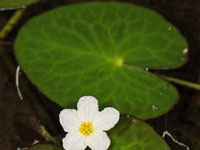
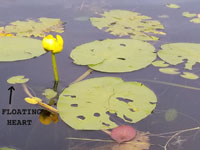
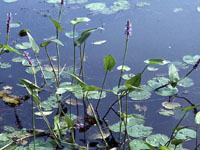
Grasses
Description: The grass family Poaceae, also known as Gramineae, has over 10,000 species. Some of these are in Jenness Pond and none of those are considered to be invasive.
Range: Eastern North America
Jenness Pond Status: Sparse
Image by: Dick DanielsRange: Eastern North America
Jenness Pond Status: Sparse
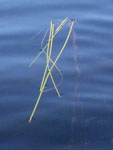
Lobelia, Water Lobelia dortmanna
Description: Water lobelia leaves are grass-like and usually submerged. It can be recognized by its 5 petaled white flower sitting on top of a thin stem and up to 12 inches out of the water.
Similar to: Nothing similar when flowering.
Pond zone: Emergent.
Range: Northern latitudes; found in all New England states.
Jenness Pond Status: Sparse
Image by: 1) Randi Hausken 2) Kjetil Rimolsronning 3) Urmas OjangoSimilar to: Nothing similar when flowering.
Pond zone: Emergent.
Range: Northern latitudes; found in all New England states.
Jenness Pond Status: Sparse
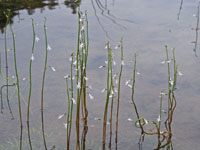
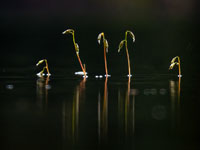
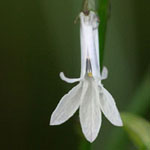
Milfoil, Native Myriophyllum
Description: A number of milfoil species are native to New England. These species are not problematic and do not adversely effect the water bodies.
Farwell's Milfoil Myriophyllum farwellii: Not found in southwestern New Hampshire but found in other parts of the state.
Low-water Milfoil Myriophyllum humile: The shape varies greatly depending on the water level.
Northern Milfoil Myriophyllum sibiricum: There are three or leaves per node on the stem. It is rare in NH. Similar to Eurasian milfoil.
Slender Milfoil Myriophyllum tenellum: The stems are slender, not bushy.
Whorled Milfoil Myriophyllum verticillatum: There are at least 3 leaves per node, whence the name "whorled". Might not be found in Rockingham county, instead in more northern counties.
Pond zone: Submergent.
Range: Northern latitudes; found in all New England states.
Jenness Pond Status: Sparse
Image by: 1) Low-water milfoil (or slender milfoil) - Pat Dowst 2) Northern milfoil - Sharika_Elahi 3) Whorled milfoil - Stefan_lefnaerFarwell's Milfoil Myriophyllum farwellii: Not found in southwestern New Hampshire but found in other parts of the state.
Low-water Milfoil Myriophyllum humile: The shape varies greatly depending on the water level.
Northern Milfoil Myriophyllum sibiricum: There are three or leaves per node on the stem. It is rare in NH. Similar to Eurasian milfoil.
Slender Milfoil Myriophyllum tenellum: The stems are slender, not bushy.
Whorled Milfoil Myriophyllum verticillatum: There are at least 3 leaves per node, whence the name "whorled". Might not be found in Rockingham county, instead in more northern counties.
Pond zone: Submergent.
Range: Northern latitudes; found in all New England states.
Jenness Pond Status: Sparse
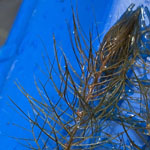
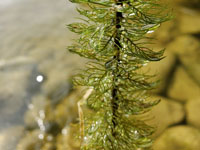
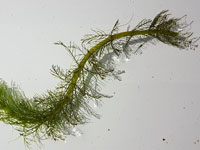
Moss Myriophyllum
Description: There are over 10,000 species of moss. I wonder how many are in our pond! One species is shown below.
Images by: Jack Gagnon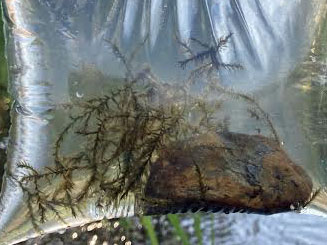
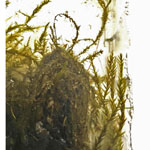

Pickerelweed Pontederia cordata
Description: The pickerelweed is an emergent vegetation with a broad leaf on a narrow round stem. The size and shape of the leaves are varible. In late summer it has elongated purple flowers.
Similar to: The flower is similar that of purple loosestrife, but the plants are very different as are their habitats.
Pond zone: Emergent.
Range: Northeast USA
Jenness Pond Status: Common
Image by: 1, 2) Dick Daniels 3) CephasSimilar to: The flower is similar that of purple loosestrife, but the plants are very different as are their habitats.
Pond zone: Emergent.
Range: Northeast USA
Jenness Pond Status: Common
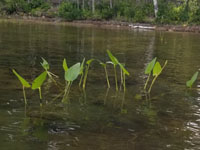
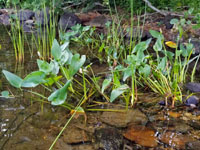
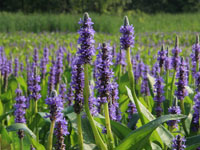
Pipewort, Northern aka Common Pipewort Eriocaulon aquaticum aka Eriocaulon septangulare
Description: The northern pipewort is one of more than 100 species of this genus. Its leaves are usually submerged. They are like blades of grass and surround a long stem that carries its flower above the water surface. This flower resembles a white button.
Pond zone: Emergent.
Range: North America, United Kinkdom, Ireland
Jenness Pond Status: Sparse
Image by: 1, 2) Jomegat 3) Northern pipewort with floating heart - Dick DanielsPond zone: Emergent.
Range: North America, United Kinkdom, Ireland
Jenness Pond Status: Sparse
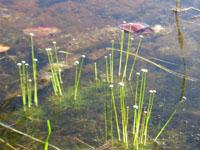

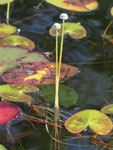
Pondweed Potamogeton
Description: Aquatic Plants and Algae of NH (NHDeS - Amy Smagula and Jody Connor) lists a number of pondweed species that are in NH lakes. Samples are listed below. They are not necessarily in Jenness Pond.
Broadleaf pondweed, Potamogeton natans: Common and floating leaves may obscure submersed leaves.
Ribbon pondweed, Potamogeton epihydrus: submersed leaves that are ribbon-like and floating leaves which are 1 to 2 inch long narrow ovals.
Bassweed, Potamogeton amplifolius: large and curly submerged weeds; floating leaves may not be abundant,
Prefoliate pondweed, Potamogeton perfoliatus: It has oval submerged leaves and no floating leaves.
Similar to: The floating leaves of some pondweed species can be confused with those of water-shield. Pondweed stems join their floating leaves at the edge, versus the center for water-shield leaves. The stems can grow close to 10 feet long.
Pond zone: Floating leaved.
Range: mainly North America
Jenness Pond Status: Scattered
Image by: 1) Broadleaf pondweed - Christian_Fischer 2) Ribbon pondweed - Petroglyph 3) Bassweed - Edward Voss 4) Prefoliat pondweed - Hanna ForsmanBroadleaf pondweed, Potamogeton natans: Common and floating leaves may obscure submersed leaves.
Ribbon pondweed, Potamogeton epihydrus: submersed leaves that are ribbon-like and floating leaves which are 1 to 2 inch long narrow ovals.
Bassweed, Potamogeton amplifolius: large and curly submerged weeds; floating leaves may not be abundant,
Prefoliate pondweed, Potamogeton perfoliatus: It has oval submerged leaves and no floating leaves.
Similar to: The floating leaves of some pondweed species can be confused with those of water-shield. Pondweed stems join their floating leaves at the edge, versus the center for water-shield leaves. The stems can grow close to 10 feet long.
Pond zone: Floating leaved.
Range: mainly North America
Jenness Pond Status: Scattered

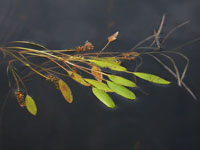
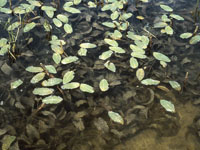
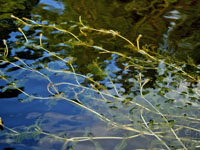
Rush, Soft aka Common Rush Juncus effusus
Description: Soft rush has a long thin stem that can reach 5 ft. Its small yellowish flower cluster is located about 8 inches from the top of the stem.
Belongs to rush family Juncaceae. There are hundreds of species of rush. They resemble grasses and sedges, but have round stems.
Similar to: If similar species of rush occur in Jenness Pond, they can theortetically be identified by the flowers. From a distance rush is similar to softstem bulrush, but softstem bulrush is a grass while a rush has round stems.
Pond zone: Emergent.
Range: All continents except Antarctica.
Jenness Pond Status: Common to abundant.
Image by: 1) Dick Daniels 2) Meggar 3) Andreas RocksteinBelongs to rush family Juncaceae. There are hundreds of species of rush. They resemble grasses and sedges, but have round stems.
Similar to: If similar species of rush occur in Jenness Pond, they can theortetically be identified by the flowers. From a distance rush is similar to softstem bulrush, but softstem bulrush is a grass while a rush has round stems.
Pond zone: Emergent.
Range: All continents except Antarctica.
Jenness Pond Status: Common to abundant.

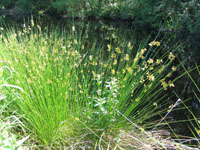
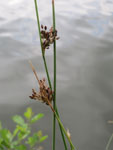
Sedge, Three-Way Dulichium arundinaceum
Description: Three-way sedge is an aquatic or semi-aquatic plant. Its stems are approximately round and hollow in structure. The leaves are comprised of small flat "spikelets" which gives the plant a thick bushy appearance. The flowers are inconspicuous (see image 2) and each produce a single seed.
Range: Almost all states of USA, also Canada
Jenness Pond Status: Sparse.
Image by: 1) Krzysztof Ziarnek 2) MinnesotaWildflower 3) Superior_National_Forest 4) Matt_Lavin Range: Almost all states of USA, also Canada
Jenness Pond Status: Sparse.
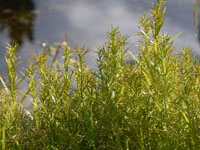
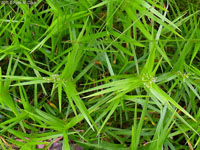


Spikerush, Grassy aka Needle Spikerush, aka Needle Spikesedge Eleocharis acicularis
Description: Grassy spikerush is a grass-like plant of the sedge family Cyperaceae. It has spiked seed heads at the end of hollow stems.
Pond zone: Emergent.
Range:.North America, Europe, Asia
Jenness Pond Status: Uncommon
Image by: 1) Grassy spikerush with some toad eggs - Pat Dowst 2) Stefan_lefnaerPond zone: Emergent.
Range:.North America, Europe, Asia
Jenness Pond Status: Uncommon
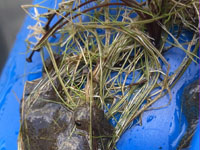

Water-lily, White Nymphaea odorata
Description: The American white water-lily has smooth floating leaves with a waxy coating which provides bouyancy. The round flat leaf often looks as if it has a wedge-shaped bite taken out of it. Their floating flowers have yellow stamens and many white petals.
Note: The similar European white water-lily, Nymphaea alba, is larger.
Pond zone: Floating leaved.
Range: Central America to northern Canada.
Jenness Pond Status: Common in scattered areas
Image by: 1) Thomas Barnes 2) Ryan Hodnett 3) Dick DanielsNote: The similar European white water-lily, Nymphaea alba, is larger.
Pond zone: Floating leaved.
Range: Central America to northern Canada.
Jenness Pond Status: Common in scattered areas

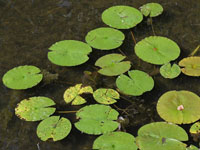
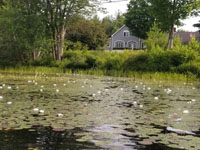
Water-lily, Yellow Nuphar lutea
Description: The yellow water-lily's flower is on a stem that reaches out of the water. Its leaf floats on the surface and has a notch similar to the American whte water-lily.
Note: The subspecies Nuphar lutea advena is also classified as a separate species, Nuphar advena which is also known as the cow-lily. It is found in eastern USA and some parts of Canada.
Pond zone: Floating leaved.
Range: North America, Europe, Africa
Jenness Pond Status: Sparse
Image by: 1) Dick Daniels 2) Matthew_Beziat 3) Claire HouckNote: The subspecies Nuphar lutea advena is also classified as a separate species, Nuphar advena which is also known as the cow-lily. It is found in eastern USA and some parts of Canada.
Pond zone: Floating leaved.
Range: North America, Europe, Africa
Jenness Pond Status: Sparse
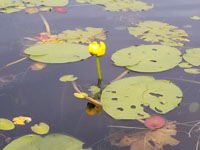
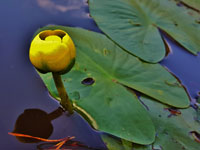

Water-shield Brasenia schreberi
Description: The water-shield leaf floats on the surface and is shaped like a shield - an oval up to 5 inches long. The underwater stems are slimmy to the touch. It has a single flower, less than an inch in diameter. The flower may be up to 4 inches out of the water.
Similar to: The floating leaves of warer-shield are similar to those of some pondweed species. Pondweed stems join their floating leaves at the edge, versus the center for water-shield leaves.
Pond zone: Floating leaved.
Range: North America, South America, Asia, Australia, Africa
Jenness Pond Status: Common
Similar to: The floating leaves of warer-shield are similar to those of some pondweed species. Pondweed stems join their floating leaves at the edge, versus the center for water-shield leaves.
Pond zone: Floating leaved.
Range: North America, South America, Asia, Australia, Africa
Jenness Pond Status: Common
Image by: 1) Dick Daniels 2, 3) Matthew_Beziat
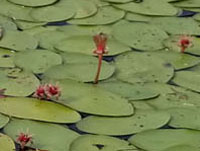
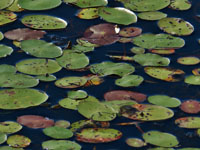
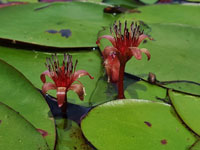
Invasive Plants of HIGH concern to Jenness Pond
Variable milfoil, Eurasian milfoil, and fanwart all all invasive plants that are found in some New Hampshire waterbodies. None of them are present in Jenness Pond and we should be vigilent as, if they become established in a waterbody they can drasticaly change it, especially in ponds relatively shallow such as Jenness Pond.
These three invasives are relatively similar in appearance and can be difficult to differentiate. If you find a plant you think may milfoil or fanwart, contact a Jenness Pond Weed Watcher or send a photo to Amy Smagula of NHDES Amy.Smagula@des.nh.gov .
Fanwort aka Carolina Fanwort aka Green Cabomba Cabomba caroliniana
Description: Carolina fanwort has mainly submerged leaves that are finely divided and arranged in pairs on the stem. When flowering there are a few floating leaves. The flower is white.
Pond zone: Submergent.
Range: North and South America, Australia
Jenness Pond Status: Not present.
Image by: 1) NHDES 2, 4) Leslie Mehrhoff 3) Steve_NicholsPond zone: Submergent.
Range: North and South America, Australia
Jenness Pond Status: Not present.
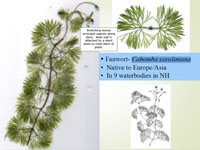

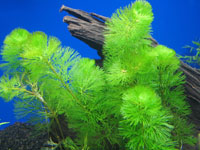
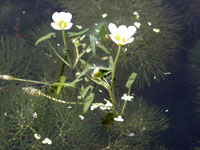
Description: Eurasian milfoil is very similar to variable milfoil. It does not grow in as deep water, but still degrades a pond substantially.
Similar to: Northern milfoil
Pond zone: Submergent.
Range: Native Europe, Asia. Invasive New Hampshire
Jenness Pond Status: Not present.
Similar to: Northern milfoil
Pond zone: Submergent.
Range: Native Europe, Asia. Invasive New Hampshire
Jenness Pond Status: Not present.
Image by: 1) NHDES 2) BerndH 3) Thayne Tuason 4) Neuchatel_Herbarium
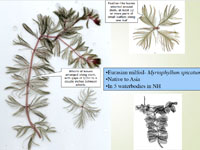



Description: Variable milfoil grows rapidly and is easily spread by boat propellors cutting it into small pieces which can later establish themselves as mature plants. Since it can grow to depths of 10 feet, this milfoil would be a disaster for a shallow pond such as Jenness Pond.
The plant is rooted at the pond bottom and the stem can grow so long, up to 15 feet, that there can be a tangled mass at the surface. Leaves connected to the relatively thick stem form a whirl. Each leaf is comprised of many feathery segments. The overall appearance of a stem with all those feather segments is similar to the fine hair of a squirrel's tail.
Similar to: It is variable in appearance and can be so similar to other water-mifoils that the only way to positively identify variable milfoil is by its flowers (see image 4 below) or a DNA analysis. When in doubt, contact an expert. Do not wait until flowers occur!
Pond zone: Submergent.
Range: North America, Europe
Jenness Pond Status: Not present.
Image by: 1) NHDES 2, 3. 4) Leslie_Mehrhoff The plant is rooted at the pond bottom and the stem can grow so long, up to 15 feet, that there can be a tangled mass at the surface. Leaves connected to the relatively thick stem form a whirl. Each leaf is comprised of many feathery segments. The overall appearance of a stem with all those feather segments is similar to the fine hair of a squirrel's tail.
Similar to: It is variable in appearance and can be so similar to other water-mifoils that the only way to positively identify variable milfoil is by its flowers (see image 4 below) or a DNA analysis. When in doubt, contact an expert. Do not wait until flowers occur!
Pond zone: Submergent.
Range: North America, Europe
Jenness Pond Status: Not present.
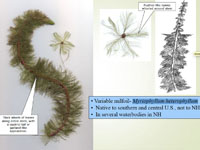
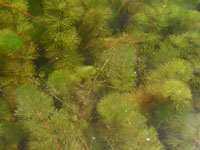
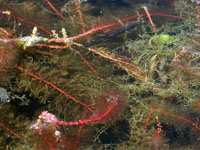
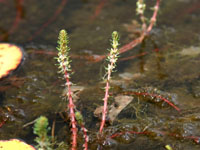
Invasive Plants of concern to Jenness Pond
Purple Loosestrife Lythrum salicaria
Description: Purple loosestrife grows in wet areas, especially on the edges lakes and ponds where there is plentiful sun. The plant grows 2 to 6 ft tall. The roots are thick and new plants can sprout from them, making eradication problematic. It flowers from early to late summer. As implied by its name the flowers are purple. The stem is square in cross-section. The leaves are opposite and whorled.
Additional information from the watershedcouncil.
Similar to: The flower is similar that of pickerelweed, but the plants are very different as are their habitats.
Pond zone: Moist ground.
Range: Europe, Asia, northwest Africa. Invasive in the Americas and Australia.
Jenness Pond Status: Scatted areas; eradication is being attempted. It is not a threat to the pond itself, but could change the character of the shoreline as each plant can produce a huge number of seeds. Even though it is invasive, it is used by bees, butterflies, and other insects, but it is a poor source for waterfowl which are adversely effected when it replaces native plants.
Additional information from the watershedcouncil.
Similar to: The flower is similar that of pickerelweed, but the plants are very different as are their habitats.
Pond zone: Moist ground.
Range: Europe, Asia, northwest Africa. Invasive in the Americas and Australia.
Jenness Pond Status: Scatted areas; eradication is being attempted. It is not a threat to the pond itself, but could change the character of the shoreline as each plant can produce a huge number of seeds. Even though it is invasive, it is used by bees, butterflies, and other insects, but it is a poor source for waterfowl which are adversely effected when it replaces native plants.
Image by: 1) Dick Daniels 2) Linda De Volder 3) Peter O'Connor
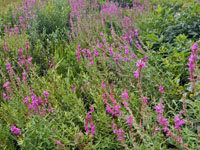

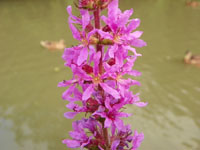
Other invasive species that are found in New England, but rarely if ever in New Hampshire
Braziliian eldoea (Egeria densa)
Hydrilla, (Hydrilla verticillata)
Water Chestnut (Trapa natans)
Water naiad aka brittle naiad (Najas minor)